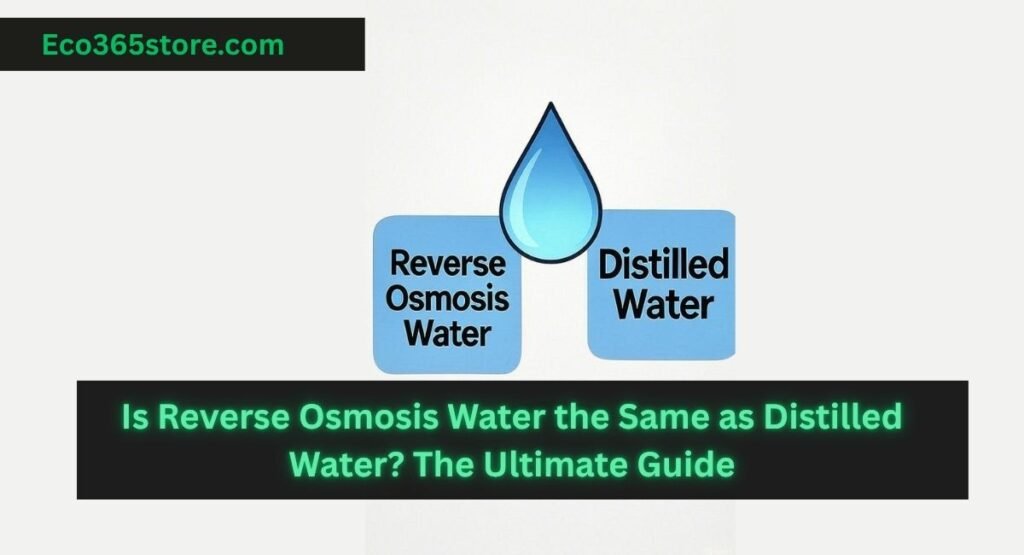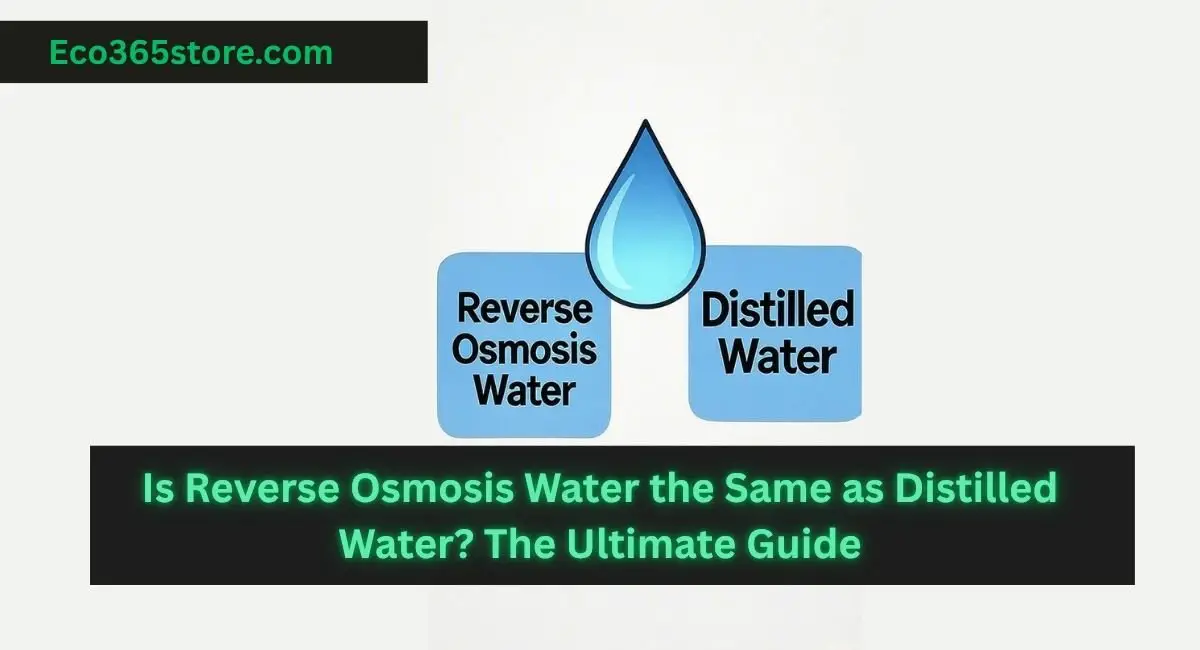Is Reverse Osmosis Water the Same as Distilled Water?
In our health-conscious world, the quality of the water we drink is more important than ever. With countless options on the market and various home purification systems available, it’s easy to get confused. Two of the most common and often misunderstood terms are reverse osmosis water and distilled water.
Many people use these terms interchangeably, asking, “Is reverse osmosis the same as distilled water?” The short answer is no. While both are highly effective purification methods, they are fundamentally different processes with distinct advantages, disadvantages, and ideal use cases.
This in-depth guide will demystify reverse osmosis water vs distilled water, exploring how they are made, what they remove, and which one is the right choice for you and your family.
What is Reverse Osmosis Water?
Reverse osmosis, commonly known as RO, is a sophisticated water filtration process. It works by forcing water under pressure through a semi-permeable membrane with incredibly tiny pores, about 0.0001 microns in size.
To understand RO, think of it as an ultra-fine sieve that only allows water molecules to pass through, while blocking the vast majority of contaminants.
What does Reverse Osmosis Remove?
A high-quality RO system is incredibly effective at removing:
- Dissolved Solids: Like salts, minerals (calcium, magnesium), and heavy metals (lead, arsenic, mercury).
- Chemical Contaminants: Such as chlorine, fluoride, and pesticides.
- Microbiological Impurities: Including bacteria, viruses, and cysts.
It’s important to note that the purity of RO water can be customized. Many modern RO filtration systems include a remineralization stage, which adds back beneficial minerals like calcium and magnesium, improving taste and adding health benefits.

What is Distilled Water?
Distilled water is created through a process of thermal distillation, one of the oldest known methods of purification. It relies on a simple principle: water is boiled until it turns into steam, leaving virtually all contaminants behind. This steam is then cooled and condensed back into pure, liquid water in a separate chamber.
This distillation process is exceptionally thorough. Since most contaminants have a much higher boiling point than water, they cannot vaporize and are left in the original boiling chamber.
What does Distillation Remove?
Distillation removes:
- All bacteria, viruses, and pathogens.
- Heavy metals, salts, and chemicals.
- Nearly 100% of minerals, including beneficial ones like calcium and potassium.
Because of its high purity, the primary distilled water uses are in medical facilities, laboratories, automotive cooling systems, and irons, where mineral-free water is critical to prevent scaling and interference.
Key Differences Between RO Water and Distilled Water
While both produce pure water, their methods and outcomes are distinct. Here’s a direct comparison of RO vs distilled water differences:
| Feature | Reverse Osmosis (RO) Water | Distilled Water |
|---|---|---|
| Process | Physical filtration through a membrane. | Phase change (boiling and condensation). |
| Mineral Content | May retain trace minerals; often remineralized. | Virtually mineral-free (99.9% removed). |
| Taste | Generally considered fresh and neutral, especially when remineralized. | Often described as “flat” or “lifeless” due to a lack of minerals. |
| Energy & Cost | More water-efficient; lower operating cost over time. | Energy-intensive (requires heat); higher ongoing cost. |
| Speed | Produces water on-demand, stored in a tank. | The distillation process is relatively slow. |
| Common Uses | Drinking, cooking, aquariums, brewing. | Medical procedures, lab experiments, irons, car batteries. |
Advantages and Disadvantages of Each
Choosing between RO and distilled water depends on your priorities. Let’s weigh the benefits of RO water against its drawbacks and do the same for distillation.
Reverse Osmosis Water
- Pros:
- Excellent for Drinking: Effectively removes harmful contaminants while allowing for remineralization for better taste and health.
- Cost-Effective: Once installed, the cost per gallon is very low.
- Convenient: Provides a continuous supply of purified water directly from your tap.
- Environmentally Friendly: Uses less energy than distillation (though it does produce wastewater).
- Cons:
- Wastewater: RO systems produce a brine stream, meaning several gallons of wastewater can be generated for every gallon of purified water.
- Removes Minerals: Without a remineralization filter, it strips water of both good and bad minerals.
- Initial Cost: A home RO system requires an upfront investment for purchase and installation.
Distilled Water
- Pros:
- Ultimate Purity: It is the gold standard for purity, removing virtually all dissolved solids.
- Ideal for Appliances: Prevents mineral scale buildup in humidifiers, irons, and medical equipment.
- Consistent Results: The process is simple and reliably produces the same result every time.
- Cons:
- Flat Taste: The lack of minerals results in a taste many find unappealing for drinking.
- High Energy Cost: The boiling process consumes a significant amount of electricity.
- Not Ideal for Daily Drinking: The lack of minerals and flat taste make it a poor choice for primary hydration for most people.
- Impractical for Whole-House Use: Typically purchased in bottles or made in small, countertop appliances.
Which is Better for Drinking?
When it comes to choosing the best purified water for daily consumption, reverse osmosis generally has the edge for most households.
The primary reason lies in the mineral content. While RO water is highly purified, it can be—and often is—remineralized. Our bodies benefit from the electrolytes and minerals found in water. Drinking demineralized water like distilled water over the long term may mean missing out on a valuable dietary source of these nutrients.
Furthermore, the taste of remineralized RO water is far superior to the flat, bland profile of distilled water, encouraging you to drink more and stay hydrated.
So, when is distilled water the better choice?
- Medical Needs: For individuals with compromised immune systems where absolute purity is critical (as advised by a doctor).
- Specific Appliances: Use distilled water in your steam iron, CPAP machine, or car battery to ensure a long lifespan.
- Short-Term Cleanses: Some people choose to drink it for short-term detoxification fasts, but it is not recommended as a long-term solution.
Environmental and Cost Considerations
When evaluating the environmental impact of water systems, both methods have trade-offs.
- Reverse Osmosis: Its main environmental drawback is water waste. However, modern RO systems are becoming more efficient, and the “waste” water can often be repurposed for watering plants or cleaning. The energy consumption is relatively low.
- Distillation: This process is an energy hog. The constant boiling requires significant electricity, which has a higher carbon footprint unless you are using renewable energy sources.
From a water purification cost perspective, an under-sink RO system has a higher initial price but a very low cost per gallon thereafter. Distilled water, if purchased in bottles, is expensive over time, and home distillers have a moderate upfront cost coupled with high ongoing energy costs.
Conclusion
So, is reverse osmosis water the same as distilled water? Clearly, they are not. The difference between RO and distilled water comes down to process, purity, and purpose.
- Choose Reverse Osmosis if your goal is high-quality, great-tasting drinking water for your home that is cost-effective and convenient for daily use, especially with a remineralizing filter.
- Choose Distillation if you need absolutely pure, mineral-free water for specific medical, laboratory, or appliance-related tasks.
Your final water purification choice should align with your specific needs for purity, taste, cost, and environmental impact. For most households seeking the best all-around clean water for drinking and cooking, a reverse osmosis system with remineralization offers the ideal balance of purity, health, and taste.
Call to Action: Before making a decision, consider testing your tap water to understand which contaminants are present. This will help you determine the level of purification you need and make an informed choice for your home.
Is reverse osmosis water the same as distilled water?
No. They are produced by different processes (filtration vs. distillation) and have different mineral contents. RO water can contain some minerals, while distilled water is almost completely mineral-free.
Can I drink distilled water every day?
While it is safe for occasional consumption, it is not recommended as a primary daily drinking water due to its lack of beneficial minerals and flat taste.
Does RO remove pesticides and viruses?
Yes, a properly maintained RO system with an intact membrane is highly effective at removing pesticides, viruses, bacteria, and a wide range of other contaminants.
Why does distilled water taste flat?
The “flat” taste is due to the absence of dissolved minerals like calcium and magnesium, which give water its characteristic fresh taste. It also has a higher pH, which can affect its taste profile.
Is remineralization necessary for RO water?
It is not strictly necessary for safety, but it is highly recommended. Remineralization significantly improves the taste and adds back beneficial minerals that contribute to your daily dietary intake.

Anamika is a passionate writer for Eco365Store.com, specializing in topics that inspire a cleaner, greener world. With expertise in home cleaning, recycling, and eco-friendly solutions, she crafts engaging and informative articles that help readers adopt sustainable practices in their daily lives.

